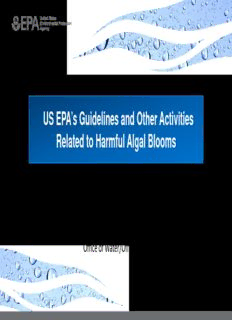
US EPA Guidelines and Other Activities Related to Harmful Algal Blooms PDF
Preview US EPA Guidelines and Other Activities Related to Harmful Algal Blooms
US EPA’s Guidelines and Other Activities Related to Harmful Algal Blooms Lesley V. D’Anglada, Dr.PH US Environmental Protection Agency Office of Water/Office of Science and Technology Tribal Science Webinar April 11th, 2017 Presentation Overview • What are harmful algal blooms? • Potential routes of exposure and adverse health effects. • EPA guidelines developed for cyanotoxins in drinking and recreational waters. • ORD research and other activities related to HABs • Monitoring techniques. • Surface water and drinking water treatment practices. • Public health guidelines. • Opportunity for Questions. Disclaimer The views expressed in this presentation are those of the author and do not necessarily represent the views or policies of the U.S. Environmental Protection Agency. 2 Overview of Harmful Algal Blooms (HABs) and Cyanotoxins • Algae are natural components of marine and freshwater flora. • Harmful Algal Blooms (HABs) occur when algae multiply growing in growth forming a scum and affecting aquatic life and water quality. • Algal blooms could cause : • Hypoxia, leading to fish kills. • Taste and odor problems in treated drinking water. • Toxins at levels that may be of concern for human health. • Economic losses from increase in treatment cost in drinking water plants and limiting recreational/fishing uses. • Presence in source water and finished drinking water: Toledo, OH (2014), Ohio River (2015), Florida, Utah, Texas, Iowa and New York (2016). 3 Cyanobacterial Blooms • In freshwater, cyanobacteria or blue-green algae, are the most common “algae”, some of which produce highly potent cyanotoxins. • One species can make multiple toxins and different toxins can be produced by a number of different species making visual monitoring difficult. • Toxins can either reside inside Freshwater Type of Toxin Causative Organism the cell (intracellular) or be Cyanotoxins released into the water Anatoxin-a Neurotoxin Anabaena spp. (extracellular). Anatoxin-a (s) Neurotoxin Aphanizomenon spp. Planktothrix spp. Cylindrospermopsi Hepatotoxin Cylindrospermopsis raciborskii, n Aphanizomenon ovalisporum Lyngbyatoxin Dermal Toxin Lyngbya spp. Microcystins Hepatotoxin Microcystis aeruginosa Anabaena spp. Planktothrix spp. Saxitoxins Neurotoxin Anabaena circinalis Lyngbya wollei 4 Exposure and Health Effects • Potential routes of exposure: • Consumption in drinking water and food • Ingestion during recreational activities • Dermal contact • Inhalation of aerosolized toxins • Health effects related to exposure to cyanotoxins: • Hepatotoxic (affects the liver) • Microcystins and Cylindrospermopsin • Neurotoxic (affects the nervous system) • Anatoxin-a and Saxitoxin • Dermatoxic (affects the skin) • Lipopolysaccharides and Lyngbyatoxin • Symptoms of acute exposure are irritation to eyes, ears, throat, rashes, and skin lesions. • Toxicity data (needed to determine thresholds) are not available for many cyanotoxins. 5 Microcystin Sampling in the 2007 and 2012 EPA National Lakes Assessment • In 2007, microcystin was detected in 32% of the lakes sampled. • In 2012, microcystin was detected in 39% of the lakes sampled. No Detectable Microcystin (2007) Detectable Microcystin (2007) • Less than 1% of lakes are in the high or moderate risk of exposure category, based on the WHO recreational exposure risk guidelines. https://www.epa.gov/sites/production/files/2016-12/documents/nla_report_dec_2016.pdf 6 Effects of Cyanotoxins in Animals and Plants • Pets and livestock can be impacted by cyanotoxins • Animals are exposed by drinking water and/or eating algal biomass (surface mats or fur grooming) • Rapid onset of symptoms and mortality • Cyanobacterial cells and toxins can contaminate spray irrigation water and subsequently be associated with crop plants. • Low levels of cyanotoxins could be absorbed by roots, migrate to shoots, and then be translocated to grains and or fruits. • Cyanotoxins concentration in grains and fruits are very low. • Generally, roots accumulated more than the leaves. • Cyanotoxins inhibit plant growth causing visible toxic effects on the plant such as leaf discoloration. • Further investigation is needed to understand the uptake and fate of microcystins and other cyanobacterial toxins by food plants. 7 Cyanotoxins and Fish • Cyanotoxins levels in edible fish and shellfish are highly variable depending on trophic level and fish organ or tissues. • Concentrations are higher in liver > gut > kidneys and gonads > muscle tissue • Concentrations are higher >phytoplanktivorous > omnivorous > carnivorous fish • More research is needed to quantify the toxicity in fish caused by cyanotoxins and the bioaccumulation in aquatic food webs. • Rather than biomagnification, biodilution seems to occur in the foodweb with toxins being subject to degradation and excretion at every level. • One of research needs identified is the need to quantify the total toxicity in fish caused by MCs variants and other secondary metabolites. 8 Current Guidelines for Cyanotoxins in Drinking and Recreational Waters 9 EPA’s Drinking Water Health Advisories (HA) • Informal technical guidance for unregulated drinking water contaminants to assist federal, state and local officials, and managers of public or community water systems in protecting public health during emergency situations. • HAs are non-regulatory concentrations in drinking water that is not expected to cause adverse non carcinogenic effects for a specific exposure period. • Acute (one-day) and Short (10-day) term exposures for infants (0 – 12 months). • Chronic (lifetime) exposures for adults. • Carcinogenic 10
Description: